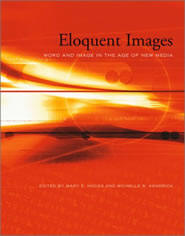
Home / Introduction / Part I / Part II / Part III / Part IV / Conclusion

III. Perception and Knowledge in Visual and Verbal Texts
Ch. 7 "Same Difference: Evolving Conclusions about Textuality and New Media." (top)
Nancy Barta-Smith and Danette DiMarco
Authors Barta-Smith and DiMarco begin with the question: How is that we speak of the visual revolution? This question directly develops the theme for this book. To answer the question, they first investigate the important contradictions about the way we talk about writing and new media. Then, using a comparative biological framework, they look to imitation to say that the so-called revolution is more an evolution from change to pattern. In other words, it is a continuity. They follow their belief up by pointing out that vision has been important all along. While at the same time they look beyond academia, Barta-Smith and DiMarco turn to history and to the work of Merleau-Ponty and Tebeaux in order to explore the challenges to the belief in a revolutionary shift from oral to print to visual. In so doing, they suggest that "disciplinary boundaries may have created a rhetoric of revolution" that is "unwarranted" (p. 173). They then conclude that such a description of visual as revolutionary prevents continuities which build on and add value to existing forms.
Ch. 8 "Illustrations, Images, and Anti-Illustrations." (top)
Jan Baetens
In this essay, Baetens describes the difficulty in using images as illustrations in nonfiction texts by adopting a more historical point of view, a view which recognizes this difficulty as something that is not new. Baetens's essay first specifically addresses the question: If we live in a so-called "visual culture," shouldn't it be possible to replace completely, and once and for all, the (nonfiction) text with a visual equivalent? In answering, he discusses the link to "visual literacy" and suggests that it is a tactical and strategic problem, that is, "how" to use images cannot be separated from "why" they should be used (p. 185). Then, after explaining the reasons for including images in nonfiction texts, Baetens moves on to a comparison between pictures of text and pictures as text which he follows with a lengthy discussion of Marshall McLuhan and Quentin Fiore's works, The Medium is the Message and War and Peace in the Global Village.
To offer a better solution, Baetens turns to a theory called "screen thinking" developed by Anne-Marie Christin. This theory reveals that there is "no longer any fundamental dichotomy of screen and sign" which means "without screen, no sign is imaginable" (p. 193). Looking at the visual from this perspective, Baetens believes, we are able to see that a writing system must not be based on the alphabetical principles such as syntax, linearity, and coherence, but rather it should be based on proximity which in turn leads the reader-spectator to chose meaning by association.
Ch. 9 "Cognitive and Educational Implications of Visually Rich Media: Images and Imagination." (top)
Jennifer Wiley
Wiley begins by addressing two questions: How does the evolution in the nature of written communication change the transmission of knowledge and to what extent can images change this relationship with text? In answering these questions, the author explores educational implications of visual adjuncts and provides examples from her own experiments that demonstrate the advantages and disadvantages of using images as adjuncts in texts. In doing so, she also explores the cognitive research from the past fifteen years which helps her to point out those advantages and disadvantages. While the studies perhaps are older, the evidence does support her claims.
Using examples from her own empirical studies, Wiley contends that successfully using visual adjuncts in texts depend on several factors such as limiting the possibility that images act as seductive details and avoiding images that serve purely decorative purposes. Although some of her conclusions seem obvious, like the idea that images should help readers better understand the concepts that are presented in the text, Wiley does provide an adequate analysis of the kinds of questions students and teachers face when working with images.
Home / Introduction / Part I / Part II / Part III / Part IV / Conclusion